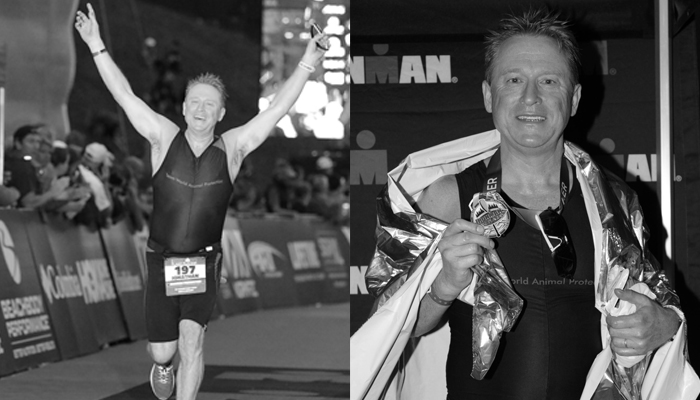

How do you train to run 7 marathons in 7 days, on 7 continents?
When I signed up for the World Marathon Challenge, I was already an experienced endurance athlete, with multiple marathons and triathlons under my belt.
But for something as monumental as the World Marathon Challenge, there’s no roadmap — no existing training plans. Instead, you have to devise your own program — one that aligns with your race goals and other factors.
So what have I been doing these past few months, exactly? I’m training two to three hours on weekdays, four to six hours on Saturday, and three to four hours on Sunday.
Yes, it’s a lot, but my training is rooted in injury prevention. There is an epidemic of endurance athletes who get injured due to overtraining or not following certain best practices, and I am determined not to join the ranks.
Cardio Training
Cardiovascular training is the heart of what I’m doing — essentially building a big aerobic engine that can easily carry me through daily marathons for a week.
Up to now, I’ve been building that engine through cross training, just as I would for a triathlon. Unlike a marathon, which involves running 26.2 miles, a triathlon comprises swimming, biking and running (the distances vary depending on the event). So you cross train — mixing up those three activities.
Although the World Marathon Challenge will only involve running, focusing on cross training up to now has many benefits when it comes to injury prevention. If I just ran at this point, I would put myself at risk for injury from overuse. However, cross training enables me to use different muscle groups, or the same muscles but with less impact, while still building up my aerobic energy.
For example, biking essentially uses the same muscles as running but without the pavement pounding. Swimming helps relax the muscles deployed for running. And both activities are still excellent for building cardiovascular endurance, especially when done with intensity.
All that said, I’ve still been doing a lot of running and now, six months from the race, I’m at a juncture where my focus on running will increase.
I’ll start doing long runs of up to 20 miles at a slower, steady pace on consecutive days (Saturday and Sunday), eventually adding a third long run on Wednesday. I’ll peak around mid-December with about 100 miles a week. Then by mid to late December, I’ll dial back on distance and focus on speed work — running shorter distances, but faster.
As before, I’ll continue to cross train and also compete regularly in triathlons, marathons and ultramarathons (longer than marathons). You can see a list of my training races here.
Strength Training, Stretching and Massage
My strength training regimen is just as important as the cardio training. I work out with free weights, TRX, and a variety of resistance aids two to three times per week to build strength — again to ward off injury and acquire greater overall fitness.
Before I start any workout, whether cardio or strength, I’m very particular about warming up. I do 10-12 minutes of yoga and dynamic stretching. Dynamic stretching is not what we learned as children in gym class. Rather than extend to a position that we hold, dynamic stretching involves actively moving muscle — like doing lunges or squats, for example.
Once ready to begin a hard cardio workout, I start slowly, working my way up to greater exertion levels.
Another part of injury prevention is massage. I get a sports massage three times a month to keep my muscles resilient. Believe me, it’s not the relaxing experience you might think. In fact, sometimes it’s unbearable. My massage therapist, Tiffany Nesfield, is also my strength coach. A former track and field star, she’s also an Olympic Weightlifter. When she puts all her strength to work on my sore muscles, I call it “Tiffany Torture,” but it is critical to successful recovery from all the training.
Team Jonathan
I couldn’t get to the start line without a support system. Top of the ticket is my athletic coach, Leslie Knibb, herself a decorated triathlete. Leslie plans all my workouts in detail, each with a specific objective, and in the evening I get a reminder email with the next day’s workout. After each session, through the wonders of technology, she can see data on all that I do — distance, speed, heart rate, power, cadence, etc. — and she provides feedback.
Besides the physical training, both these amazing athletes have been able to coach me on nutrition and the all-important mental side of endurance athletics — developing a relationship with pain and using visualization to my advantage (more on all that in a future post).
Finally, there are my wife and children, my staff at KCIC, Children’s National Health System staff, as well as all those who have given toward my primary cause: to raise awareness and improve the lives of children with mental illness.
As I go about this, I’m inspired by the American swimmer Diana Nyad. In 2013, at the age of 64, and after five tries over 35 years, she accomplished her dream of swimming the 103 miles between Cuba to Florida without a shark cage. Her subsequent book “Find A Way” shows you that with determination and the right execution, something that seems impossible actually is possible. Coming out of the water on her final, successful attempt, she said three things:
I could not agree with her more.
Follow Jonathan’s training on Instagram and visit taketherisk.run to support his mission to raise $1 million to upgrade the inpatient mental health unit at Children’s National Health System in Washington, D.C.
You can also read a recent interview with Jonathan in the Washington Business Journal about his World Marathon Challenge training and mental health mission.
Never miss a post. Get Risky Business tips and insights delivered right to your inbox.

Jonathan Terrell is the Founder and President of KCIC. He has more than 30 years of international financial services experience with a multi-disciplinary background in accounting, finance and insurance. Prior to founding KCIC in 2002, he worked at Zurich Financial Services, JP Morgan, and PriceWaterhouseCoopers.
Learn More About Jonathan